The first thing that comes to mind when talking about Taipei’s Neihu District may be the Neihu Technology Park, teeming with modern high-rise office buildings. That, however, is not the whole picture of Neihu. Admired for its beautiful mountain and lake scenery, Neihu is also home to several historical sites. Among them, the newly renovated Guo Ziyi Memorial Hall — formerly the Neihu Guo Family Estate, also known as Neihu’s “Red House” — has been officially open to the public since Feb. 3. It was established in honor of a Tang Dynasty statesman Guo Ziyi (697-781), known for his impressive feats 1,250 years ago.
Guo Ziyi — the ancestor of the world’s Guo (often spelled “Kuo” in Taiwan) clan — earned his fame for ending the An Shi Rebellion in 755 and other disturbances and served under four Tang emperors, namely the Xuanzong, Suzong, Daizong, and Dezong emperors. In 762, Guo was made Prince of Fenyang for his achievements. In addition, there is an anecdote about Guo Ziyi in a popular Peking opera titled “Hitting the Princess While Drunk,” which tells of the harmonious and intellectual relationship between him and the Daizong Emperor.
Built in 1917, the 130-ping (426.2m2) two-story Western-style red-brick house spreads out over a 360-ping (1,178m2) area. The roughly T-shaped building was decorated with washed terrazzo, earthen sculptures, colored tiles imported from Japan, and Baroque-style embellishments. The red bricks are larger (about 4 inches) and denser than those of today. The floors were made of wood and supported by a good number of fir wood beams. There were also painted beams for hanging traditional Taiwanese censers and lanterns. The windows on the front facade are in different shapes, and there is an arc-shaped balcony and a charming Baroque-style balustrade with charming curves on top of the wall. A statue of Guo Ziyi is placed in the main hall. A variety of historical documents are on display, including the Tang poet Li Bai’s poem in praise of the Prince of Fenyang, rubbings from Tang Dynasty tablets by the Prince of Fenyang, and other calligraphy works and paintings. In addition, Fenyang wine and miniature figurines of Guo Ziyi are sold in the hall.
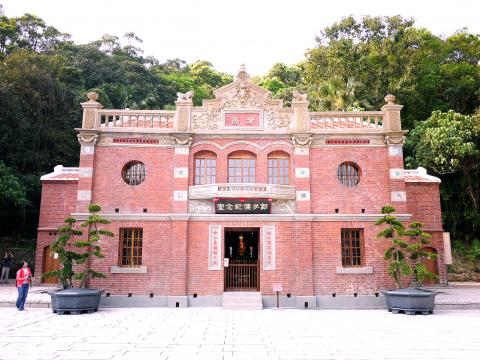
Photo: Lin Ya-ti, Taipei Times
照片:台北時報林亞蒂
The Guo Ziyi Memorial Hall was the home of the first Neihu Village mayor Kuo Hua-jang during the Japanese colonial era, and it was designated as a municipal historical heritage site by the Taipei City Government in 1999. Despite being designated as a historical site, the house continued to be neglected for more than a decade. Thank to the efforts of the World Guo’s Clan Association President Kuo Shih-chi, starting October, 2010, the house was given a year-long facelift by Guo Ching-po — another member of the Guo clan and a master craftsman specialized in the restoration work of historical sites. The total renovation cost was approximately NT$50 million. The World Guo’s Clan Association donated more than NT$30 million of these funds and the Taipei City Government provided more than NT$10 million. Today, the once dilapidated house is coming back to life once more, inviting people to appreciate the beauty of its architecture and soak up the ambience of times gone by. Admission to the Guo Ziyi Memorial Hall is free and the hall is closed every Monday. Address: 19, Ln 267, Wende Rd, Neihu District, Taipei. Tel: (02) 2659-8787.
(Lin Ya-ti, Taipei Times)
說到台北市內湖區,腦海可能會出現現代辦公大樓林立的內湖科技園區,但這並非內湖的全貌。好山好水的內湖,也富含人文古韻,坐擁多處古蹟,其中位於捷運文德站一號出口旁的小山丘上,就藏著一棟剛修建完成素有「內湖紅樓」之稱的內湖郭氏古宅,二月三日正式以「郭子儀紀念堂」之名對外開放,紀念唐朝軍事政治家郭子儀(西元六九七至七八一),在一千兩百五十年前的豐功偉績。
郭子儀是世界郭氏宗親先祖,曾平定西元七五五年的安史之亂以及諸多亂事,戰功彪炳,歷事唐朝玄、肅、代、德四帝,於西元七六二年被封為汾陽郡王。另外,中國民間戲曲有一齣膾炙人口的傳統曲目《醉打金枝》,即是講述唐代宗與郭子儀君臣之間相處圓融與智慧的趣聞軼事。
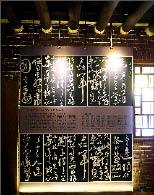
Photo: Lin Ya-ti, Taipei Times
照片:台北時報林亞蒂
這棟建於一九一七年以紅磚堆砌而成的一百三十坪(四百二十六點二平方公尺)兩層洋樓,占地三百六十坪(一千一百七十八平方公尺)。建築平面略呈T字形,有洗石子、泥塑、日本進口彩瓷,以及巴洛克繁飾。磚頭比起現代用的紅磚來得大(約四吋)且密度更高。室內樓板為木造,以眾多杉木木樑支撐,另外還有彩繪燈樑,可懸掛台灣傳統的天公爐與燈籠。正立面的窗子形式富變化,弧形陽台,山頭造型仿巴洛克風格,富捲草曲線之美。郭子儀像供奉在正廳,而周圍則展示著各式文物,包含唐朝詩人李白的《汾陽王贊》、唐代碑刻《汾陽王置寺表》拓本,以及各式書畫。除此以外,館內還販售汾陽酒與郭子儀迷你公仔。
「郭子儀紀念堂」原是內湖在日據時期首任庄長郭華讓的宅第,一九九九年被台北市政府列為市定古蹟,但這棟年久失修的古蹟,繼續被閒置十多年,直到二○一○年十月,在世界郭氏宗親總會理事長郭石吉的努力下,由古蹟匠師同時也是郭氏宗親的郭清波承攬修建工程,修復工程總共耗資新台幣五千萬元,其中郭氏宗親認捐三千多萬,而台北市政府則補助一千多萬。歷經一年多的修復努力,原來破舊不堪的古厝,如今再度被賦予生機,吸引民眾前來領略其建築之美、發思古之幽情。「郭子儀紀念堂」免費參觀,每週一休館。地址:台北市內湖區文德路二六七巷十九號。電話:(02) 2659-8787。
(台北時報記者林亞蒂)
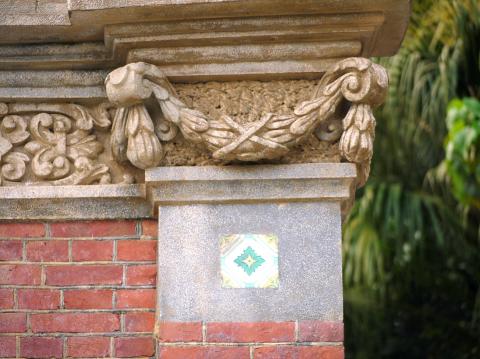
Photo: Lin Ya-ti, Taipei Times
照片:台北時報林亞蒂
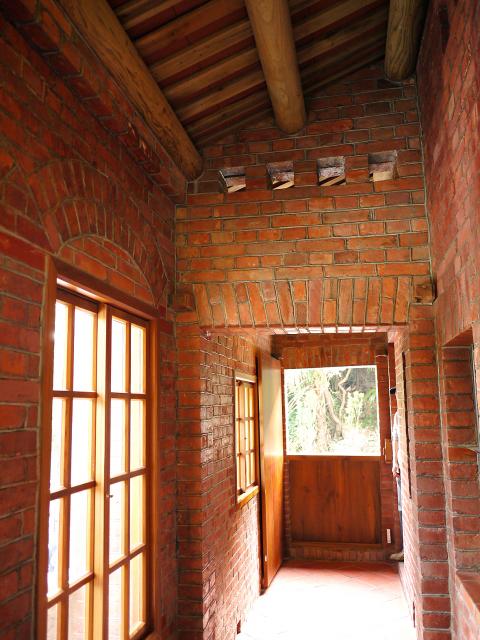
Photo: Lin Ya-ti, Taipei Times
照片:台北時報林亞蒂
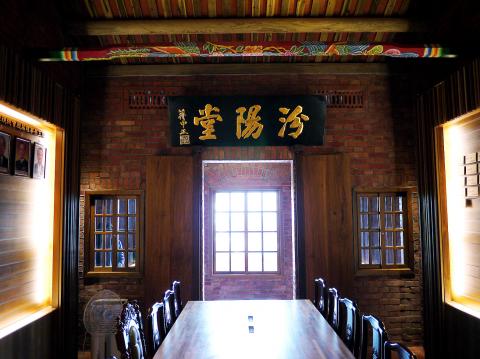
Photo: Lin Ya-ti, Taipei Times
照片:台北時報林亞蒂
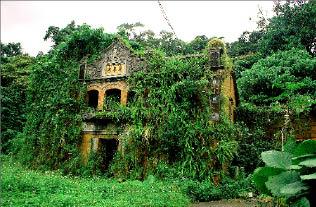
Photo: Perry Svensson, Taipei Times
照片:台北時報蘇沛

In an effort to fight phone scams, British mobile phone company O2 has introduced Daisy, an AI designed to engage phone con artists in time-wasting conversations. Daisy is portrayed as a kindly British granny, exploiting scammers’ tendency to target the elderly. Her voice, based on a real grandmother’s for authenticity, adds to her credibility in the role. “O2” has distributed several dedicated phone numbers online to direct scammers to Daisy instead of actual customers. When Daisy receives a call, she translates the scammers’ spoken words into text and then responds to them accordingly through a text-to-speech system. Remarkably, Daisy

Bilingual Story is a fictionalized account. 雙語故事部分內容純屬虛構。 Emma had reviewed 41 resumes that morning. While the ATS screened out 288 unqualified, she screened for AI slop. She could spot it a mile away. She muttered AI buzzwords like curses under her breath. “Team player.” “Results-driven.” “Stakeholder alignment.” “Leveraging core competencies.” Each resume reeked of AI modeling: a cemetery of cliches, tombstones of personality. AI wasn’t just changing hiring. It was draining the humanity from it. Then she found it: a plain PDF cover letter. No template. No design flourishes. The first line read: “I once tried to automate my

Every May 1, Hawaii comes alive with Lei Day, a festival celebrating the rich culture and spirit of the islands. Initiated in 1927 by the poet Don Blanding, Lei Day began as a tribute to the Hawaiian custom of making and wearing leis. The idea was quickly adopted and officially recognized as a holiday in 1929, and leis have since become a symbol of local pride and cultural preservation. In Hawaiian culture, leis are more than decorative garlands made from flowers, shells or feathers. For Hawaiians, giving a lei is as natural as saying “aloha.” It shows love and

1. 他走出門,左右看一下,就過了馬路。 ˇ He walked outside, looked left and right, and crossed the road. χ He walked outside and looked left and right, crossed the road. 註︰並列連接詞 and 在這句中連接三個述語。一般的結構是 x, y, and z。x and y and z 是加強語氣的結構,x and y, z 則不可以。 2. 他們知道自己的弱點以及如何趕上其他競爭者。 ˇ They saw where their weak points lay and how they could catch up with the other competitors. χ They saw where their weak points lay and how to catch up with the other competitors. 註:and 一般連接同等成分,結構相等的單詞、片語或子句。誤句中 and 的前面是子句,後面是不定詞片語,不能用 and 連接,必須把不定詞片語改為子句,and 前後的結構才相等。 3. 她坐上計程車,直接到機場。 ˇ She took a cab, which took her straight to the airport. ˇ She took a cab and it took her straight